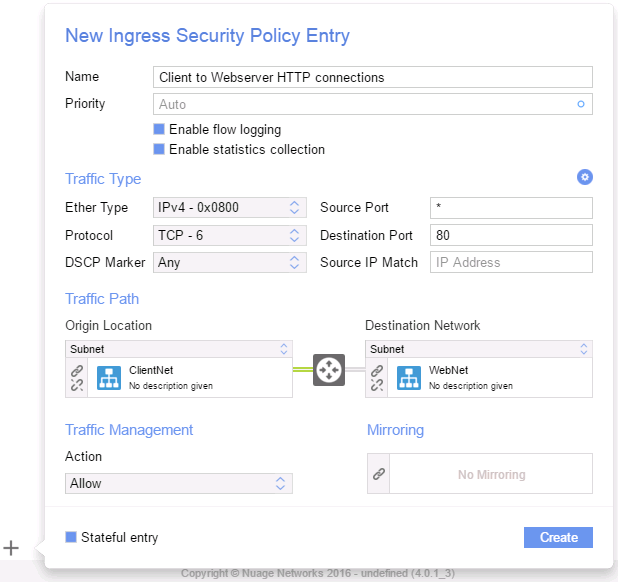Introduction
Within this blog, we will focus on the stateful firewalling capability that was introduced in R4.0 for TCP and ICMP traffic types. Stateful firewalling for TCP means that the platform will follow the different stages of a TCP session setup and teardown. For ICMP, Nuage Networks will map ICMP requests for specific sub-types to their corresponding response sub-types and create the relevant return flow on the VRS. It basically provides a higher level of protection against L3/L4 attacks and prevents assymetric routing of traffic (ie. return traffic has to follow the same path).
The parts I will detail out are:
- Configuration aspects
- Querying the session state
- Upgrade implications
Configuration aspects
Configuring an Ingress/Egress policy for stateful inspection is very straightforward: it is sufficient to turn on the “stateful” flag as part of entering the rule.

When using the VSPK, or VSD CLI, you have to make sure the stateful flag is set to true within the ACL Entry object:
from vspk import v4_0 as vsdk
# Creating or fetching Ingress ACL Template on a domain or domain template
...
ingress_acl_entry_properties = {
"network_type": "ANY",
"network_id": None,
"location_type": "ANY",
"location_id": None,
"stateful": True,
"source_port": "*",
"protocol": "6",
"ether_type": "0x0800",
"dscp": "*",
"destination_port": "80",
"description": "Allow HTTP traffic between all",
"action": "FORWARD"
}
ingress_acl_entry = vsdk.NUIngressACLEntryTemplate(**ingress_acl_entry_properties)
ingress_acl.create_child(ingress_acl_entry)Please note that if you like rule enforcement at both source and destination, make sure to configure an ingress as well as an egress rule.
Querying session state
Handling the stateful inspection of a TCP session is fully handled by the VRS - with hooks into the OpenvSwitch flow tables to track the status of each session. To demonstrate this, we will analyze the traffic between two virtual machines with IP 172.16.0.72 (client) and IP 10.10.10.11 (server).
To query the state of a particular session, the ovs-appctl command has been extended with an additional action bridge/dump-conntracks. It allows the operator to list out the state of each session. When cycling through the different stages of a successful TCP session setup and tear down, the output of running this command is shown below:

Upgrade Implications
Stateful ACL inspection is the natural successor of using reflexive rules. As such, when you perform an upgrade from 3.2 to 4.0, any reflexive ACL rules will automatically be promoted to stateful.
If you use the VSPK or the API, you still have the possibility of using the v3_2 version inside your scripts while working with a 4.0 environment. When you create a IngressACLEntryTemplate or EgressACLEntryTemplate, the reflexive property of v3_2 will be translated to the stateful property in the VSD.
If you decide to upgrade your scripts to v4_0, please pay attention to your scripts: the reflexive property will not be accepted anymore and you have to specify a value for the stateful property instead.
Conclusion
So I hope you have enjoyed reading up how Nuage VSP now brings stateful TCP flow inspection. Please let us know if you like us to cover any other R4.0 feature in a future post !
Jonas